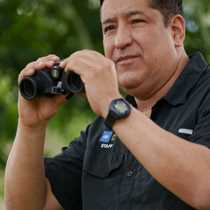Casual and Pucate River
Our first full day of the expedition in the Peruvian Upper Amazon was of great success. We woke up early to take full advantage of it. Before breakfast at around 6:30, our trustful skiff fleet headed out to explore one of the thousands of small black water creeks, locally known as “caños.” We found several Neotropical rain forest bird species like Shiny Cowbirds, Black-capped Donacobious, Yellow-headed Caracaras, Ringed Kingfishers, Yellow-rumped Caciques, Oriole Blackbirds, and many more. A Common Pauraque (Nyctidromus albicollis) resting on a branch was a highlight. This bird species is widespread all over the Marañon River and can be spotted mainly at night using strong spotlights. It was a great and unusual sighting to see one at daytime. Pauraques are similar to nightjars and weer-poorwills. All these night-dweller birds are cryptically colored and active at night when they sally insects. Pauraques rather than seen, just like their allies, are most easily detected, and identified, by their peculiar and beautiful voices.
More than the various animal sightings, however, we had a chance to listen to the wonderful sounds of the rain forest in the early morning. Our guests began to calibrate their senses to the patterns and movements of the inhabitants of the rain forest. Branches bobbing under a bird’s weight, a wooden reed being pulled by the currents, monkeys´ chirping sounds, exotic calls, and voices were beginning to make sense to us.
After breakfast we headed out again, this time in rubber boots. We were ready to walk in “terra firme” trail in a place known as Casual. This area never gets flooded therefore we can use it to walk on firm land in a reserve that is approximately 80% underwater the whole year round. The Pacaya-Samiria Reserve is the largest flooded protected area in Peru. The interior of the Amazonian rain forest is very different from the river itself. It isn’t open. It’s still and shady and harbors an intricate yet fascinating entanglement of every kind of tropical vegetation. One of the most impressive sightings on the trail is that of a huge strangler fig reaching tree hood. This kind of plant begins high in the canopy as a harmless epiphyte. It sprouts in the crook of a tree and reaches toward the light. Meanwhile, its roots are reaching downward at some point reaching the forest floor. The roots wrap around the tree from which they descend, and anchor themselves. They grow thicker. They fuse like a maze. They completely unsheathe the tree that originally supported them, at last strangling it. Wonderful isn’t it?
During the walk several species of amphibians and reptiles were seen as well. A couple of natives who accompanied us today found the most beautiful Poison Dart frogs, a Whipping Snake, and some lizards.
Back aboard the Delfin II, we cooled off with refreshing Amazon fruit juices and a shower and then gathered for a talk about the many details, cyphers and insights of the Amazon region, one of my favorite subjects. After this talk we had a safety drill and a map orientation by Juan Luis Ihuaraqui, one of our Delfin II naturalists. With that foundation, we set off in the late afternoon to explore the Pucate River, one of the largest black water streams coming out of the Pacaya-Samiria Reserve. The view of infinite shades of green that make up Amazonian riverside vegetation reflected in a dark obsidian-like color of a black water river is a visual memory that is hard to beat.
The afternoon was hot, but it cooled soon enough when we were approaching sunset. At the entrance of the river several pink and gray river dolphins were seen working trying to catch fish.
Wonderful sightings of the afternoon included Brown three-toed sloths, a yellow-crowned brush-tailed tree rat peering out of its hollow roost, and several birds of prey, macaws, parrots, etc. Sunset brought a spectacular beauty to this day’s end. We can hardly wait to see what new adventures are waiting for us in this paradise.




